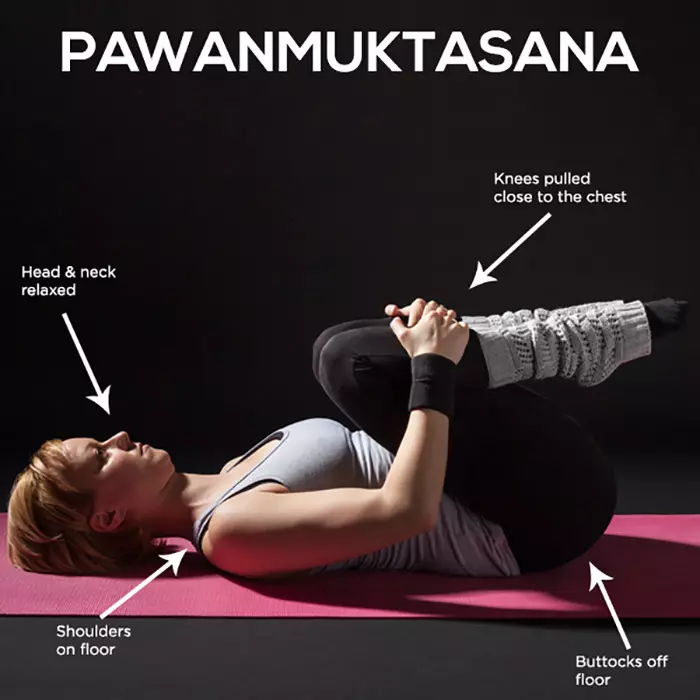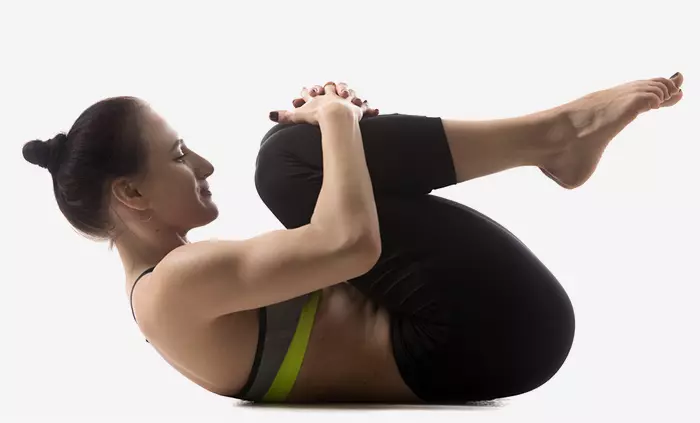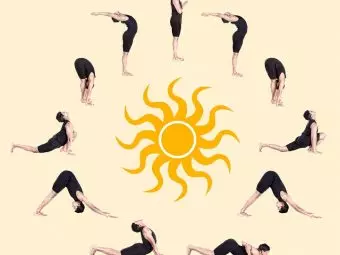Sanskrit: पवनमुक्तसन (PUH-vuhn-mukt-AAHS-uh-nuh) Pawan: wind, Mukta: release or relieve, Asana: pose
The benefits of pavanamuktasana, also known as wind-liberating, wind-relieving, or wind-removing pose, are quite a long list to go through. In fact, it is an ideal posture to start your day with to let out the digestive gases from the stomach and intestines. It is easy to perform and suitable for beginners too. In this article, we look at the science behind this wind-relieving pose, its long list of benefits, its preparatory and follow-up postures, and precautions to take. Let’s get started!
In This Article
Everything You Need To Know About The Pawanmuktasana
What You Should Know Before You Do The Asana
It is best to practice this asana first thing every morning so that all the trapped gases in your digestive tract are released. This should also be one of the first asanas you practice as once the gases are released, it will make practicing other asanas easier. Yoga must be practiced at least four to six hours after a meal, when your stomach and bowels are both empty.

Image: Shutterstock
- Level: Basic
- Style: Vinyasa
- Duration: 10 to 60 seconds
- Repetition: None
- Stretches: Abdomen, Lower Back, Arms
- Strengthens: Back, Digestive System, Reproductive System
How To Do Pawanmuktasana
- Lie flat on your back on a smooth surface, ensuring that your feet are together, and your arms are placed beside your body.
- Take a deep breath. As you exhale, bring your knees towards your chest, and press your thighs on your abdomen. Clasp your hands around your legs as if you are hugging your knees.
- Hold the asana while you breathe normally. Every time you exhale, make sure you tighten the grip of the hands on the upper shins , and increase the pressure on your chest. Every time you inhale, ensure that you loosen the grip.
- Exhale and release the pose after you rock and roll from side to side about three to five times. Relax.
Precautions And Contraindications
These are a few points of caution to keep in mind before you do the Pawanmuktasana.
- This asana must be avoided if you have had an abdominal surgery recently. Also, people suffering from hernia or piles must avoid this asana.
- This asana must not be practiced by pregnant women. Menstruating women can avoid this asana if they are not comfortable.
- If you are suffering from heart problems, hyperacidity, high blood pressure, slip disc, hernia, back and neck problems, or a testicle disorder, you must avoid this asana.
- If you have had a neck injury, but have a doctor’s approval to practice this asana, your head must remain on the floor. Support your neck with a rolled yoga blanket or bath towel while doing the asana.
Beginner’s Tips
Although you must keep your buttocks lifted off the floor, try to keep your lower back grounded on the floor as you practice this asana.
Advanced Pose Alterations

Image: Shutterstock
To deepen the pose, lift your head and chest off the floor. Touch your chin, and eventually, your nose to your knee.
The Benefits Of The Wind Relieving Pose
These are some amazing benefits of Pawanmuktasana.
- It strengthens the abdominal muscles and massages the intestines and internal organs of the digestive system, therefore releasing trapped gases and improving digestion.
- It strengthens the back muscles and tones the muscles of the arms and the legs.
- It improves the circulation of blood in the hip area.
- It eases the tension in the lower back.
- It stimulates the reproductive organs and massages the pelvic muscles.
- It helps burn fat in the thighs, buttocks, and abdominal area.
- It helps to stretch the back and neck.
The Science Behind The Pawanmuktasana
Relieving your system of the pressure that it builds up every day is extremely relaxing to your body, mind, and spirit. This asana is a gentle reminder of your body’s ability to heal itself. It might be a good idea to do this asana first thing every morning, just before you get out of bed. When you gently wake your body with this asana, you will notice that your body functions with greater ease throughout the day.
Preparatory Poses
Sulabh Pawanmuktasana – Keeping the head on the floor
Ardha Pawanmuktasana – Bending only one leg
Follow-Up Poses
Dwi Pada Uttanpadasana
From strengthening the digestive and reproduction systems to aiding in letting out the wind from the digestive tract, the benefits of pawanmuktasana are immense. Starting your yoga routine with this pose makes it easier to perform other asanas. This wind-relieving pose, which should be done on an empty stomach, also helps improve blood circulation in the hip area, helps shed fat in the buttocks, thighs, and abdomen, and strengthen the back and neck. However, pregnant women and those with a history of abdominal surgery, heart and back issues, neck injury, hypertension, hyperacidity, etc., must avoid this pose.
Frequently Asked Questions
How long should I hold Pawanmuktasana?
You should hold Pawanmuktasana for 30 seconds. However, avoid this posture if you have neck or spinal problems.
How many times should we do Pawanmuktasana?
You must do Pawanmuktasana first thing in the morning every day for desired results.
Related
The following two tabs change content below.
- Author
- Reviewer

Shirin Mehdi
A jack of many trades and a master of some, Shirin is a writer, a fashion designer, and a chef… more
Anirudh Gupta
(Certified Yoga Instructor)Anirudh is a Certified Yoga Instructor – RYT 200 – Yoga Alliance from Yoga Vedanta Centre. His teaching style incorporates… more



 7 Best Yoga Poses To Relieve Allergic Rhinitis
7 Best Yoga Poses To Relieve Allergic Rhinitis 24 Effective Yoga Poses For Back Pain – Get Instant Relief
24 Effective Yoga Poses For Back Pain – Get Instant Relief 7 Yoga Poses For Beauty
7 Yoga Poses For Beauty 5 Deep Breathing Exercises Of Pranayama For Good Oxygen Levels
5 Deep Breathing Exercises Of Pranayama For Good Oxygen Levels 20 Things You Must Know Before You Start Practicing Yoga
20 Things You Must Know Before You Start Practicing Yoga What Is The Best Time To Do Yoga?
What Is The Best Time To Do Yoga? Reiki Meditation – How To Do And What Are Its Benefits?
Reiki Meditation – How To Do And What Are Its Benefits? 7 Easy Steps To Do Pranic Healing Meditation
7 Easy Steps To Do Pranic Healing Meditation 5 Effective Yoga Poses To Increase Your Stamina
5 Effective Yoga Poses To Increase Your Stamina